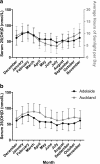Vitamin D levels in an Australian and New Zealand cohort and the association with pregnancy outcome
- PMID: 29925344
- PMCID: PMC6011374
- DOI: 10.1186/s12884-018-1887-x
Vitamin D levels in an Australian and New Zealand cohort and the association with pregnancy outcome
Abstract
Background: Pregnant women are at increased susceptibility to vitamin D deficiency. Hence, there is continuing interest in determining how vitamin D influences pregnancy health. We aimed to compare vitamin D status in two distinct populations of pregnant women in Australia and New Zealand and to investigate the relationship between vitamin D status and pregnancy outcome. This included evaluating possible effect measure modifications according to fetal sex.
Methods: Serum 25-hydroxy vitamin D (25(OH)D) was measured at 15 ± 1 weeks' gestation in 2800 women from Adelaide and Auckland who participated in the multi-centre, prospective cohort SCreening fOr Pregnancy Endpoints (SCOPE) study.
Results: Mean serum 25(OH)D in all women was 68.1 ± 27.1 nmol/L and 28% (n = 772) were considered vitamin D deficient (< 50 nmol/L). Serum 25(OH)D was lower in the women recruited in Adelaide when compared to the women recruited in Auckland and remained lower after adjusting for covariates including maternal body mass index and socioeconomic index (Adelaide: 58.4 ± 50.3 vs. Auckland: 70.2 ± 54.5 nmol/L, P < 0.001). A 53% decreased risk for gestational diabetes mellitus (GDM) was observed with high (> 81 nmol/L) "standardised" vitamin D status when compared to moderate-high (63-81 nmol/L, aRR, 0.47; 95% CI: 0.23, 0.96). Marginal sex-specific differences occurred between vitamin D status and GDM: women carrying a female fetus had a 56% decreased risk for GDM in those with low-moderate levels of standardised vitamin D (44-63 nmol/L) compared to moderate-high levels (aRR: 0.44; 95% CI: 0.20, 0.97), whilst in women carrying a male fetus, a 55% decreased risk of GDM was found with high standardised vitamin D when compared to moderately-high vitamin D, but this was not statistically significant (aRR: 0.45; 95% CI: 0.15, 1.38).
Conclusions: High serum 25(OH)D at 15 ± 1 weeks' gestation was shown to be protective against the development of GDM. A possible association between fetal sex, vitamin D status and GDM provides further questions and encourages continual research and discussion into the role of vitamin D in pregnancy, particularly in vitamin D replete populations.
Keywords: Fetal sex; Gestational diabetes mellitus; Pregnancy; Pregnancy outcome; Vitamin D.
Conflict of interest statement
Ethics approval and consent to participate
This study was approved by the relevant human ethics committees and all participants provided written informed consent (Adelaide: Central Northern Adelaide Health Service Ethics of Human Research Committee on 2 September 2005, ethics number REC 1714/5/2008 and Auckland: Northern Region Ethics Committee on 23 April 2003, ethics number AKX/02/00/364).
Consent for publication
Not applicable.
Competing interests
The authors declare that they have no competing interests.
Publisher’s Note
Springer Nature remains neutral with regard to jurisdictional claims in published maps and institutional affiliations.
Figures

Similar articles
-
Lower vitamin D levels in Saudi pregnant women are associated with higher risk of developing GDM.BMC Pregnancy Childbirth. 2018 Apr 10;18(1):86. doi: 10.1186/s12884-018-1723-3. BMC Pregnancy Childbirth. 2018. PMID: 29631547 Free PMC article.
-
Maternal vitamin D deficiency in early pregnancy is not associated with gestational diabetes mellitus development or pregnancy outcomes in Korean pregnant women in a prospective study.J Nutr Sci Vitaminol (Tokyo). 2014;60(4):269-75. doi: 10.3177/jnsv.60.269. J Nutr Sci Vitaminol (Tokyo). 2014. PMID: 25297616
-
The relationship between 25-hydroxyvitamin D concentration in early pregnancy and pregnancy outcomes in a large, prospective cohort.Br J Nutr. 2016 Oct;116(8):1409-1415. doi: 10.1017/S0007114516003202. Epub 2016 Oct 18. Br J Nutr. 2016. PMID: 27753425
-
Early pregnancy maternal vitamin D concentrations and risk of gestational diabetes mellitus.Paediatr Perinat Epidemiol. 2015 May;29(3):200-10. doi: 10.1111/ppe.12182. Epub 2015 Mar 23. Paediatr Perinat Epidemiol. 2015. PMID: 25808081 Free PMC article. Review.
-
Vitamin D and pregnancy outcomes: Overall results of the FEPED study.J Gynecol Obstet Hum Reprod. 2020 Oct;49(8):101883. doi: 10.1016/j.jogoh.2020.101883. Epub 2020 Jul 27. J Gynecol Obstet Hum Reprod. 2020. PMID: 32730862 Review.
Cited by
-
The Role of Lifestyle Interventions in the Prevention and Treatment of Gestational Diabetes Mellitus.Medicina (Kaunas). 2023 Feb 1;59(2):287. doi: 10.3390/medicina59020287. Medicina (Kaunas). 2023. PMID: 36837488 Free PMC article. Review.
-
The Impact of Nutritional Supplementation During Pregnancy on the Incidence of Gestational Diabetes and Glycaemia Control.Front Nutr. 2022 Apr 8;9:867099. doi: 10.3389/fnut.2022.867099. eCollection 2022. Front Nutr. 2022. PMID: 35464031 Free PMC article. Review.
-
Systematic review and meta-analysis of vitamin D deficiency in different pregnancy on preterm birth: Deficiency in middle pregnancy might be at risk.Medicine (Baltimore). 2021 Jun 18;100(24):e26303. doi: 10.1097/MD.0000000000026303. Medicine (Baltimore). 2021. PMID: 34128867 Free PMC article.
-
Mushrooms: a food-based solution to vitamin D deficiency to include in dietary guidelines.Front Nutr. 2024 Apr 10;11:1384273. doi: 10.3389/fnut.2024.1384273. eCollection 2024. Front Nutr. 2024. PMID: 38660061 Free PMC article.
-
Vitamin D Deficiency and Risk of Gestational Diabetes Mellitus in Western Countries: A Scoping Review.Nutrients. 2025 Jul 25;17(15):2429. doi: 10.3390/nu17152429. Nutrients. 2025. PMID: 40806014 Free PMC article. Review.
References
-
- Chowdhury R, Kunutsor S, Vitezova A, Oliver-Williams C, Chowdhury S, Kiefte-de-Jong JC, Khan H, Baena CP, Prabhakaran D, Hoshen MB, et al. Vitamin D and risk of cause specific death: systematic review and meta-analysis of observational cohort and randomised intervention studies. BMJ. 2014;348:g1903. doi: 10.1136/bmj.g1903. - DOI - PMC - PubMed
Publication types
MeSH terms
Substances
Grants and funding
LinkOut - more resources
Full Text Sources
Other Literature Sources
Medical

